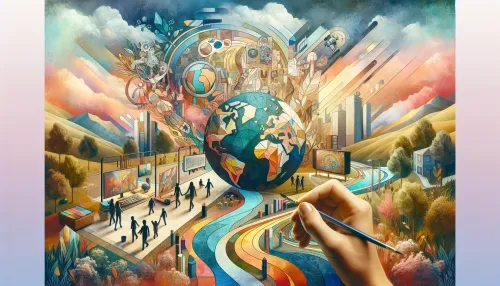Autistic Archetypes in Pop Culture Iconography: Origins, Evolution, and Cultural Significance

HorizonsMind Blog is excited to delve into the fascinating realm of autistic archetypes in popular culture. The representations of autism in various forms of media, art, and literature have a profound impact on societal perceptions. Let's embark on a journey to uncover the historical origins, evolution, and cultural significance of these archetypes and their implications for individuals with autism spectrum disorder (ASD).
The historical representation of autism in popular symbols provides valuable insights into the evolving perceptions of neurodiversity. Throughout history, individuals with autism have been depicted through symbols that reflect prevailing societal attitudes. From ancient cultural artifacts to modern-day media representations, the symbolism associated with autism has undergone significant transformations.
Historical Representations of Autism in Popular Culture
In ancient civilizations, subtle references to autistic traits can be found in artistic expressions and mythological narratives. The enigmatic depictions of solitary figures engrossed in specialized activities hint at the presence of individuals with autistic traits in ancient societies. These historical symbols offer glimpses into the challenges and triumphs experienced by individuals who possessed characteristics now recognized as indicative of autism.
The cultural imprinting of autism heavily influences public perceptions and attitudes toward neurodiverse individuals. Popular culture has played a pivotal role in shaping the collective understanding of autism, often perpetuating stereotypes or providing authentic portrayals that foster empathy and acceptance.
Cultural Influences on Public Perceptions of Autism
Media representations, such as films, television shows, and literature, have contributed to a spectrum of portrayals ranging from stigmatizing caricatures to nuanced, empathetic characterizations. While some depictions have reinforced misconceptions about autism, others have humanized the experiences of individuals with ASD, fostering a more inclusive social narrative.
In recent years, advocacy efforts and increased awareness have led to a more diverse range of autistic characters in popular culture. These contemporary portrayals reflect a growing appreciation for the multifaceted nature of autism and aim to debunk myths while celebrating the unique strengths and perspectives of neurodiverse individuals.
The recasting of iconic figures through neurodiverse perspectives presents an opportunity to challenge traditional archetypes and broaden representation in popular culture. By reimagining well-known characters through neurodiverse lenses, creators can showcase the richness and diversity of autistic experiences while promoting greater inclusivity.
This transformative approach not only enriches the narrative landscape but also cultivates a deeper understanding of autism within society. Through the portrayal of iconic figures with neurodiverse traits, audiences are encouraged to embrace the spectrum of human cognition and behavior, fostering an environment that celebrates diversity and individuality.
Reimagining Iconic Figures with Neurodiverse Perspectives
Archetypes serve as powerful amplifiers of neurodiverse representation in popular culture, influencing how audiences perceive and relate to autistic characters. By recognizing and dismantling outdated stereotypes while embracing authentic archetypes that reflect the diversity of autistic experiences, creators can contribute to a more inclusive cultural landscape.
As archetypal representations evolve, they gradually shape public consciousness, leading to increased awareness and acceptance of neurodiversity. Through intentional storytelling and imagery, creators have the opportunity to redefine archetypes associated with autism, paving the way for more accurate and respectful representations that resonate with individuals across the spectrum.
The Role of Archetypes in Neurodiverse Representation
In conclusion, exploring the historical origins, cultural impact, and transformative potential of autistic archetypes in pop culture unveils a complex tapestry woven with evolving perceptions, diverse portrayals, and opportunities for enhanced representation. As society continues to embrace neurodiversity, it is essential for creators and audiences alike to engage critically with archetypal representations, championing narratives that authentically reflect the richness of autistic experiences.
By embracing inclusive storytelling and uplifting authentic voices within popular culture, we can foster a more empathetic, diverse, and inclusive world for individuals with autism.
Frequently Asked Questions
The historical representations of autism in popular symbols reveal how societal attitudes towards neurodiversity have evolved. From ancient artifacts to modern media, these symbols reflect both the challenges and triumphs of individuals with autistic traits, providing insight into their experiences throughout history.
Popular culture significantly shapes public perceptions of autism by portraying neurodiverse individuals in various ways. While some media reinforce stereotypes, others offer authentic representations that foster empathy and understanding, ultimately contributing to a more inclusive narrative about autism and its complexities.
Recasting iconic figures through neurodiverse perspectives is crucial as it challenges traditional archetypes and broadens representation. This approach enriches narratives and promotes inclusivity, encouraging audiences to appreciate the diversity of autistic experiences while fostering a deeper understanding of autism in society.
Archetypes serve as powerful tools for amplifying neurodiverse representation in popular culture. By recognizing and dismantling outdated stereotypes, creators can embrace authentic archetypes that reflect the diversity of autistic experiences, leading to greater awareness and acceptance of neurodiversity among audiences.
Storytelling can promote inclusivity for individuals with autism by uplifting authentic voices and narratives that reflect their experiences. By engaging critically with archetypal representations, creators can foster empathy and understanding, ultimately contributing to a more diverse and accepting society for all.
Check Out These Related Articles

Reimagined Therapies: Art-Based Approaches and Creative Expression Techniques Enriching the Lives of Autistic Children

Uniting Through Art: Global Projects Connecting Autistic Children Across Borders

Crafting Genius: The Synergy of STEM and Art in Nurturing Autistic Minds
